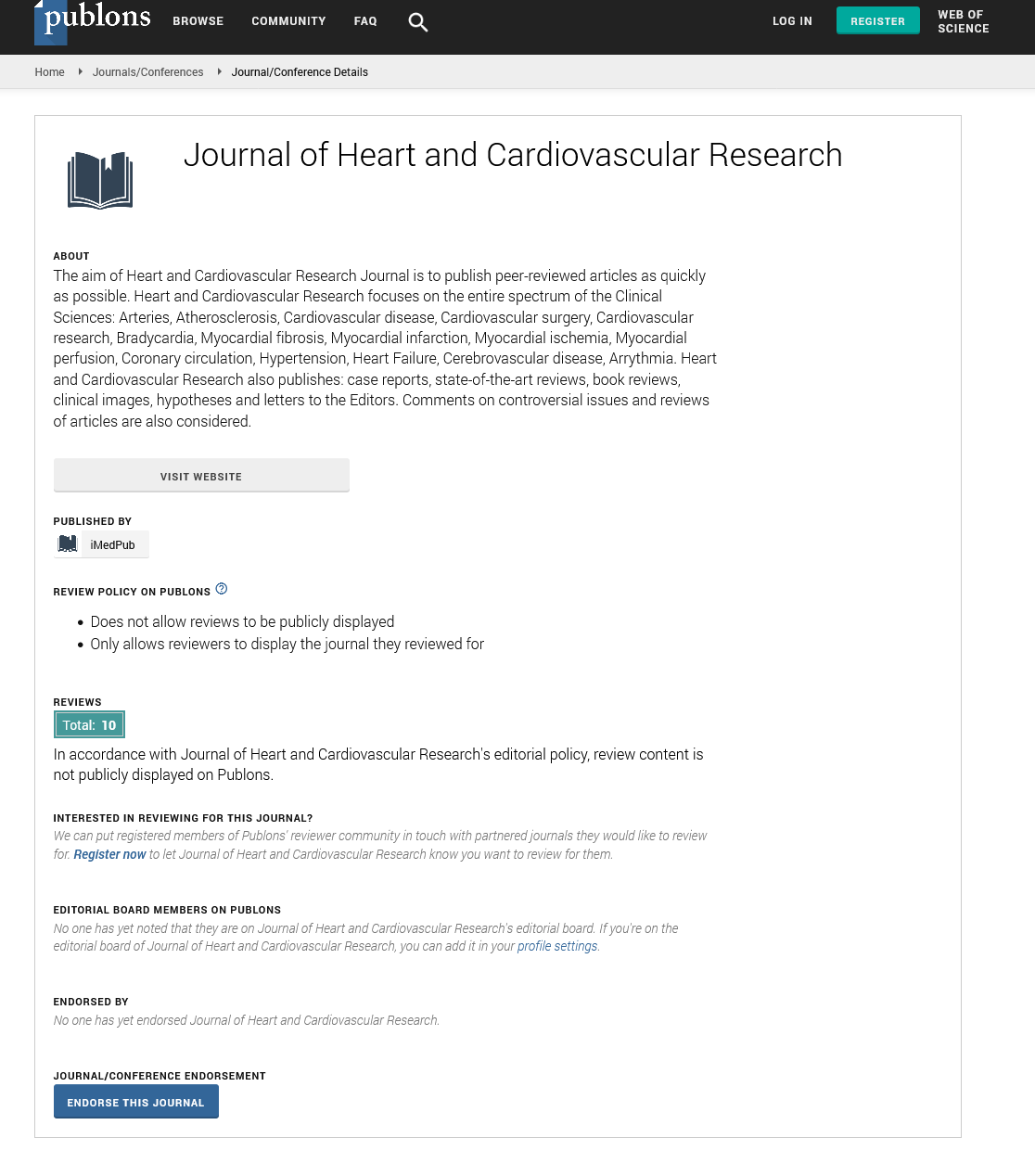ISSN : ISSN: 2576-1455
Journal of Heart and Cardiovascular Research
Abstract
Animal Models of Calcific Aortic Valve Disease (or Valvular Diseases)
Valvular heart disease account for more 24,811 deaths each year in the United States alone, being the most commonly affected aortic valve[1].It has been experimentally demonstrated that calcific aortic valve disease (CAVD) is currently the leading cause of heart valve disease in industrialized and developing countries [2]. CAVD comprises from early sclerosis, characterized by thickening of the cusps without obstructing left ventricular outflow, to late stenosis with stiffened leaflets, flow obstruction, and impaired cardiac function [3]. CAVD are considered one of the main public health concern historically it was believed to be a passive “senile” or “degenerative” process affecting a normal trileaflet or congenital bicuspid valve and is now the most common cause of Aortic stenosis (AS) in adults [4],but in the last decade, various studies have determined several notable molecular processes have involved in the development of this disorder and recent scientific discoveries have also shown it is an active and highly cell-mediated pathobiological process[5].The results of both are significant: sclerosis is associated with a 50% increased risk of cardiovascular death and myocardial infarction and the prognosis for patients with stenosis is very poor (20 – 60% mortality) [6]. CAVD accounts for 50% of valvular heart disease and is the third most common cardiovascular disease following coronary disease and hypertension [7], Available evidence shows that≈50% of patients with AVS do not have clinically significant atherosclerosis. It is important to stress that mechanical injury caused by hemodynamic stress during the constant opening and closing of leaflets is thought an important risk factor for AVS. The congenital bicuspid aortic valve, which contributes to a high mechanical stress, reportedly leads to a rapid progression of AVS in younger patients with low atherosclerotic risk. Furthermore, the non-coronary leaflet is more likely to be affected compared to other leaflets due to increased mechanical stress as a consequence of the absence of diastolic coronary flow.[9]. Tissue prosthetic valves have also been observed to calcify early through a process that resembles the natural history of bicuspid aortic valves. [10]. The prevalence of Aortic valve sclerosis (AVSc) presents in 25% to 30% of patients aged >65 years, 40% of those aged >75years [11, 12] and in up to 75% of those aged >85 years, with severe AS reaching a 3% prevalence in the population over 75 years[13]. Evidence from other studies suggests that chronic inflammation is critical not only for atherosclerotic calcification but also for CAVD. This is revealed in human disease by the existence of macrophages ,T cells, sub endothelial oxidized low---SMA) positive cells, associated with late CAVD, are only infrequently found within primary lesions (~22%) [14], [15], [16], [6]; raised superoxide and hydrogen peroxide[17]; decreased endothelial nitric oxide synthase levels and increased oxidative stress [18];complement activation[19];elevated expression of tumor necrosis factor-α(TNF-α),active mast cells, matrix metalloproteinases (MMP-1, -2, -3, -9)[20], interleukin-2 (IL-2), angiotensin converting enzyme (ACE), angiotensin II (AngII), angiotensin II type-1 receptor (AT1R) and chymase [14]; and VEC expression of intracellular adhesion molecule-1 (ICAM-1), vascular cell adhesion molecule-1 (VCAM-1) [15], and E-selectin[21]. Inflammatory processes are associated with, and may drive, the valve ECM abnormalities that are characteristic of CAVD, including leaflet thickening, collagen turnover, and fibrosis[22]; accumulation of proteoglycans and hyaluronan, fragmentation of elastin [6]; and calcification [17], [23]. Conclusively, it is a maladaptation of the valve ECM (often located in the fibrous layer) that causes valve stiffness and dysfunction. While many features of human CAVD are well described (particularly for late-stage human CAVD), there is little understanding of early sclerosis. The few reports describing early human valvular lesions suggest similarities to early atherosclerotic lesions[24-27], but more than 60% of patients with CAVD do not have clinically significant coronary atherosclerosis[28], suggesting divergent processes. Therefore, there is an unmet scientific need to determine pathobiological mechanisms of CAVD and identify new approaches to treat CAVD. Animal models are emerging as vital tools to this end, facilitated by the advent of new models and improved understanding of the utility of existing models. In this paper, we summarize and critically appraise current small and large animal models of CAVD, discuss the utility of animal models for priority CAVD research areas, and provide recommendations for future animal model studies of CAVD.
Author(s): Ahmad Shah Baghlani
Abstract | Full-Text | PDF
Share This Article
Google Scholar citation report
Citations : 34
Journal of Heart and Cardiovascular Research received 34 citations as per Google Scholar report
Journal of Heart and Cardiovascular Research peer review process verified at publons
Abstracted/Indexed in
- Google Scholar
- Sherpa Romeo
- China National Knowledge Infrastructure (CNKI)
- Publons
Open Access Journals
- Aquaculture & Veterinary Science
- Chemistry & Chemical Sciences
- Clinical Sciences
- Engineering
- General Science
- Genetics & Molecular Biology
- Health Care & Nursing
- Immunology & Microbiology
- Materials Science
- Mathematics & Physics
- Medical Sciences
- Neurology & Psychiatry
- Oncology & Cancer Science
- Pharmaceutical Sciences
